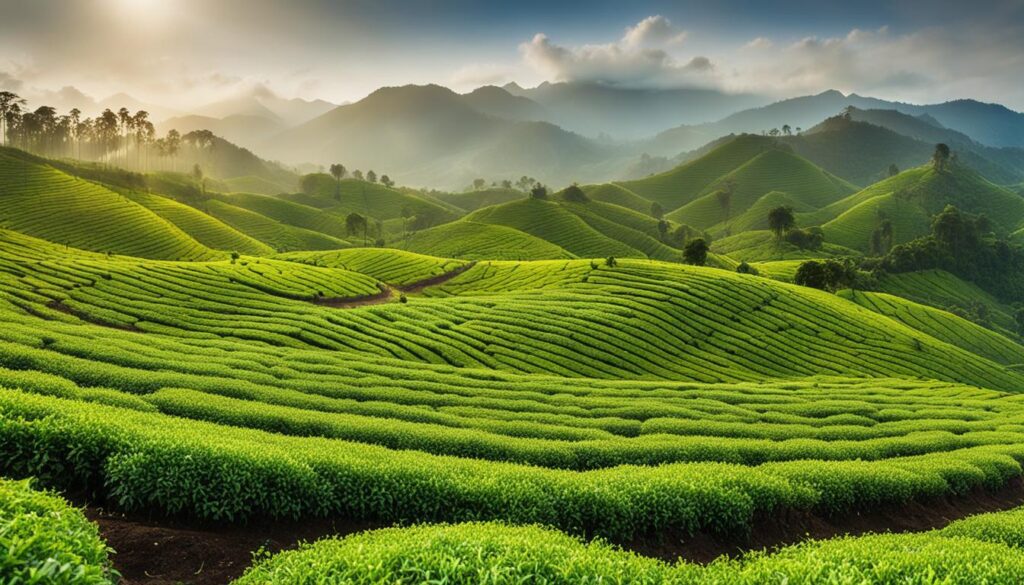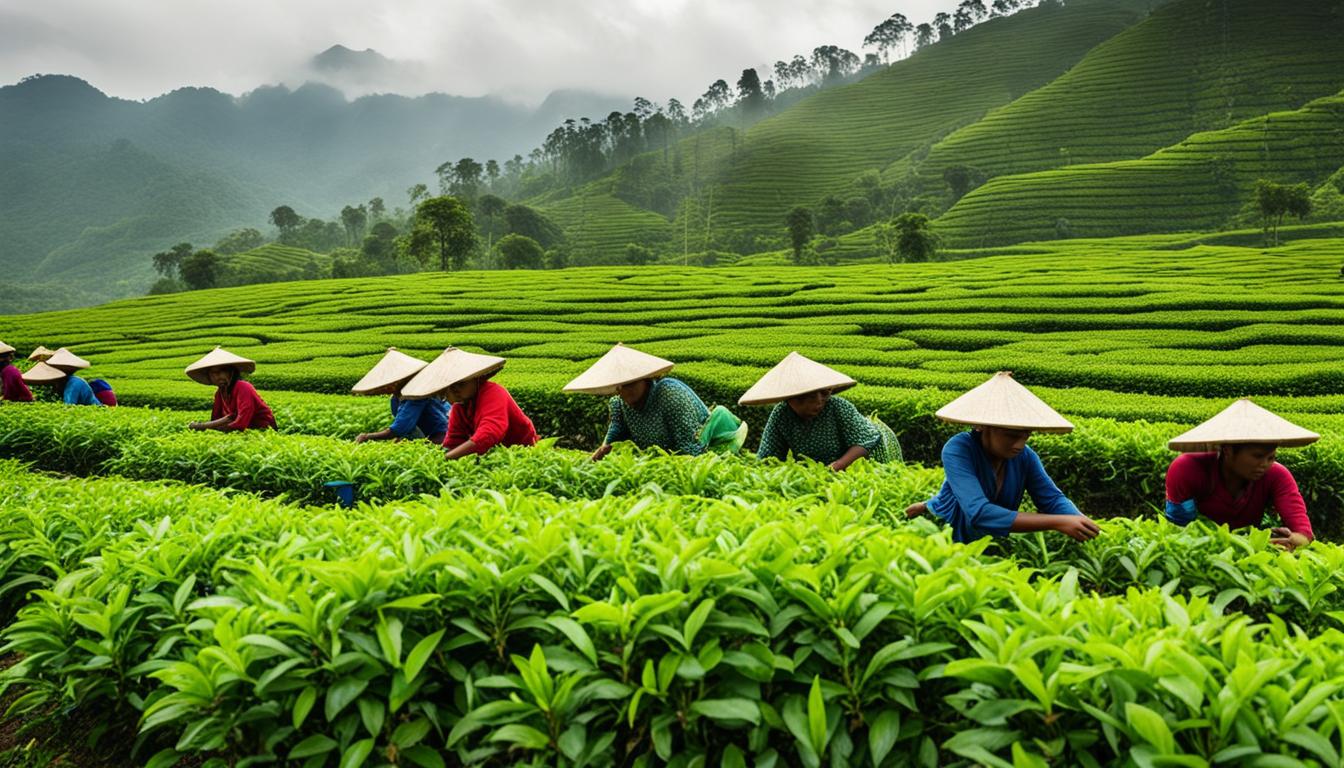Welcome to our guide on managing tea plantations! If you’re looking to establish a successful and profitable tea plantation, you’ve come to the right place. In this article, we’ll provide you with valuable tips and strategies to help you navigate the world of tea plantation management. From developing a solid business plan to selecting the right location and understanding market trends, we’ve got you covered. So, grab your favorite cup of tea and let’s dive in!
Key Takeaways:
- Thoroughly research the tea industry and understand market trends before starting a tea plantation.
- Identify your target market and understand customer demographics to develop an effective business plan.
- Conduct a feasibility study to assess market demand, competition, and potential profitability.
- Factors like location, climate, tea type, and efficient management practices play a crucial role in determining profitability.
- Select the right site and prepare the land properly for a healthy tea plantation.
Researching the Tea Industry
Before embarking on the journey of managing a tea plantation, it is vital to conduct thorough research on the tea industry. This research will provide valuable insights into market trends, consumer preferences, and the overall landscape of the industry. Understanding these factors will help shape a successful tea plantation business plan.
Exploring Market Trends
Staying informed about the latest market trends is essential in developing a competitive edge in the tea industry. By analyzing data and studying industry reports, we can identify emerging trends and consumer demands. This knowledge allows us to make informed decisions regarding tea varieties, flavors, and packaging that align with market preferences.
Understanding Consumer Preferences
Consumer preferences play a significant role in shaping the success of a tea plantation. Conducting research on target customers’ demographics, taste preferences, and purchasing habits helps us tailor our offerings to meet their needs. By understanding what consumers look for in their tea, we can create products and marketing campaigns that resonate with our target audience.
“Researching the tea industry provides valuable insights into market trends and consumer preferences, allowing tea plantation owners to make informed decisions.”
Identifying Opportunities for Growth
Researching the tea industry provides us with valuable information about potential growth opportunities. By examining the market landscape, we can identify gaps in the market, explore untapped customer segments, and discover unique selling propositions that set our tea plantation apart from competitors. This research allows us to identify profitable avenues for growth and innovation.
Summary:
Researching the tea industry is a critical step in successfully managing a tea plantation. By exploring market trends, understanding consumer preferences, and identifying growth opportunities, we can develop a business plan that aligns with the market’s demands. This research equips us with the knowledge needed to make strategic decisions that drive the profitability and success of our tea plantation.
Identifying Target Market and Customer Demographics
When it comes to managing a tea plantation, understanding your target market and customer demographics is essential for success. By identifying and analyzing your target market, you can tailor your products and marketing strategies to meet their needs and preferences. Let’s take a closer look at how to identify your target market and the importance of customer demographics in the tea industry.
Researching the Tea Market: Before you can identify your target market, it’s important to research the tea market thoroughly. Look into trends and emerging preferences in the industry, such as the growing demand for organic teas or the popularity of unique blends. Stay up-to-date with industry publications and blogs to gain insights into changing consumer preferences and market dynamics.
Defining your Ideal Customer: Once you have a good understanding of the tea market, it’s time to define your ideal customer. Consider factors such as age, gender, location, and lifestyle preferences. For example, you may target health-conscious individuals who prioritize organic and natural products or tea enthusiasts who appreciate high-quality loose-leaf teas.
Conducting Surveys and Market Research: To gain deeper insights into your target market, consider conducting surveys and market research. This can help you understand their buying behaviors, preferences, and motivations. You can also analyze your competitors to identify gaps in the market and differentiate your offerings.

By identifying your target market and understanding customer demographics, you can optimize your tea plantation management strategies for success. Remember to stay adaptable and evolve your strategies as the market changes to ensure continued growth and profitability.
Conducting a Feasibility Study
Before embarking on the journey of starting a tea plantation, it is crucial to conduct a thorough feasibility study. This study is essential in evaluating the viability and potential profitability of the venture. By assessing market demand, competition, and potential risks, we can gather valuable insights to inform our decision-making process.
The feasibility study begins with extensive research on the tea market, analyzing current trends and understanding the dynamics of supply and demand. By gathering data on consumer preferences and behavior, we can identify opportunities and gaps in the market that our plantation can fulfill.
Market demand plays a significant role in determining the success of a tea plantation. Through comprehensive market research and analysis, we can gain valuable insights into the potential profitability of our venture. Understanding our target market and their preferences will enable us to tailor our offerings to meet their needs and increase our chances of success.
In addition to assessing market demand, a feasibility study also evaluates the financial feasibility of the tea plantation. This involves estimating the initial investment required, analyzing ongoing operational costs, and projecting potential revenue streams. By conducting a thorough financial analysis, we can identify any potential challenges and develop strategies to mitigate them.
By conducting a comprehensive feasibility study, we equip ourselves with the knowledge and insights necessary to make informed decisions about starting and managing a tea plantation. It allows us to assess the market demand, evaluate potential profitability, and identify any risks or challenges that may arise. Armed with this information, we can develop strategies to maximize our chances of success and create a thriving and profitable tea plantation.
Factors that Determine the Profitability of a Tea Plantation
When it comes to running a profitable tea plantation, several factors play a crucial role. Let’s explore these key factors that can significantly impact the success and profitability of your tea business.
Location
The location of your tea plantation is of utmost importance. Choosing an area with suitable climate and soil conditions for tea cultivation is essential for maximizing yield and quality. Factors such as altitude, rainfall, sunlight exposure, and temperature variations all contribute to the overall success of your tea plantation. Conduct thorough research to identify regions that are known for producing high-quality tea and ensure that your chosen location meets the specific requirements of the tea variety you plan to cultivate.
Climate
The climate of your chosen tea plantation site plays a significant role in determining the profitability of your venture. Different tea varieties have specific climate requirements, so it is crucial to select a location that aligns with the needs of your chosen tea type. Whether it’s a cool mountainous region for producing delicate green teas or a tropical climate for robust black teas, understanding and catering to the specific climate needs of your tea plants will contribute to their health, growth, and ultimately, your profitability.
Tea Type
The type of tea you choose to cultivate can have a direct impact on the profitability of your plantation. Different tea varieties have varying market demands and price points. Conduct market research to identify popular tea varieties and determine the consumer demand for specific types. By aligning your tea production with market demands, you can ensure a steady demand for your products, leading to increased profitability.
Market Demand
Understanding market demand is crucial for the profitability of your tea plantation. Research consumer preferences, identify target markets, and stay updated with tea industry trends to ensure that your tea products align with current market demands. By offering unique, high-quality teas that cater to the preferences of your target customers, you can position your plantation for greater profitability.
| Factors | Impact on Profitability |
|---|---|
| Location | Determines the availability of suitable climate and soil conditions for tea cultivation |
| Climate | Affects the growth and quality of tea plants |
| Tea Type | Influences market demand and price points |
| Market Demand | Ensures a steady demand for your tea products |

As a tea plantation owner, it is essential to consider these factors when developing your business plan and making strategic decisions. By carefully selecting the location, understanding the climate requirements, choosing the right tea types, and aligning your products with market demand, you can increase the profitability of your tea plantation and create a successful and thriving business.
Site Selection and Land Preparation
When it comes to starting a successful tea plantation, the site selection is a critical factor that can significantly impact its overall productivity and success. Choosing the right location is essential to ensure optimal growth conditions for tea plants and maximize yield. Let’s explore the key considerations for site selection and the necessary land preparation steps.
Soil Conditions
The soil conditions of the selected site play a crucial role in the growth and health of tea plants. Tea plants prefer well-drained soil with good water-holding capacity. Sandy loam or loamy soils are often the most suitable for tea cultivation, as they provide a balanced combination of drainage and moisture retention. Testing the soil for pH level, fertility, and organic matter content is essential to ensure it meets the specific requirements for tea cultivation.
Shelter from Winds
Tea plants are delicate and can be easily damaged by strong winds. Therefore, it is important to select a site with natural or artificial barriers that provide adequate protection from prevailing winds. Natural windbreakers, such as tall trees or hills, can be advantageous in preventing wind damage to the tea plants. If natural barriers are not available, constructing windbreak fences or hedges can be effective in providing the necessary shelter.
Land Preparation
Once the site is selected, proper land preparation is crucial to create an optimal environment for tea plantation establishment. This includes clearing the land of any vegetation and debris, plowing or tilling to break up the soil, and removing any large rocks or obstacles. Depending on the soil conditions, amendments may be necessary to enhance fertility and provide essential nutrients to support healthy tea plant growth. It is also important to create appropriate shade structures to protect the young tea plants from excessive sunlight, especially in the initial stages.
| Key Steps in Land Preparation | Benefits |
|---|---|
| Clearing the land of vegetation and debris | Creates a clean and organized planting site |
| Plowing or tilling the soil | Loosens the soil and promotes better root penetration |
| Removing rocks and obstacles | Prevents interference with tea plant growth |
| Amending soil fertility | Provides necessary nutrients for healthy tea plant growth |
| Constructing shade structures | Protects young tea plants from excessive sunlight |
Proper site selection and land preparation are crucial steps in establishing a successful tea plantation. By carefully considering soil conditions, ensuring shelter from winds, and following the necessary land preparation steps, tea plantation owners can create an ideal environment for healthy tea plant growth and maximize their chances of long-term success.
Conclusion
We’ve covered a lot in this article, exploring the key strategies and tips for successfully managing a tea plantation. By implementing effective management practices and following the right steps, you can increase your chances of achieving profitability and success in this industry.
Thorough research and planning are essential. Take the time to understand the tea industry, identify your target market, and conduct a comprehensive feasibility study. By doing so, you’ll gain valuable insights that will guide your decision-making process.
Remember, the success of a tea plantation relies on various factors such as location, climate, tea type, and market demand. Ensure you choose the right site, implement sound management practices, and stay updated with industry trends.
With dedication, perseverance, and effective management, your tea plantation can thrive and contribute to the growth of the tea industry. By applying the tips and strategies discussed in this article, you’ll be well on your way to achieving profitability and running a successful business.
FAQ
Why is a business plan important for managing a tea plantation?
A solid business plan helps to set clear goals, identify target markets, and determine financial requirements for a tea plantation.
What research should be done on the tea industry?
Research should include studying different tea types, market trends, tea-growing regions, regulations, certifications, and attending trade shows.
Why is identifying the target market important?
Understanding the target market and customer demographics helps in developing effective marketing strategies and reaching the right customers.
What is a feasibility study and why is it necessary?
A feasibility study assesses market demand, competition, profitability, and potential risks before starting a tea plantation, ensuring a well-informed decision-making process.
What factors determine the profitability of a tea plantation?
Factors such as location, climate, tea type, market demand, and efficient management practices all contribute to the profitability of a tea plantation.
How do you select the right site for a tea plantation?
The right site should have suitable soil, climate, and water conditions, and proper site preparation, including shade construction and nursery maintenance, is vital.
How can I manage a tea plantation successfully?
To manage a tea plantation successfully, it is important to have effective planning, thorough research, and a sound business strategy in place, taking into account factors such as market demand, tea type, and efficient plant management.





